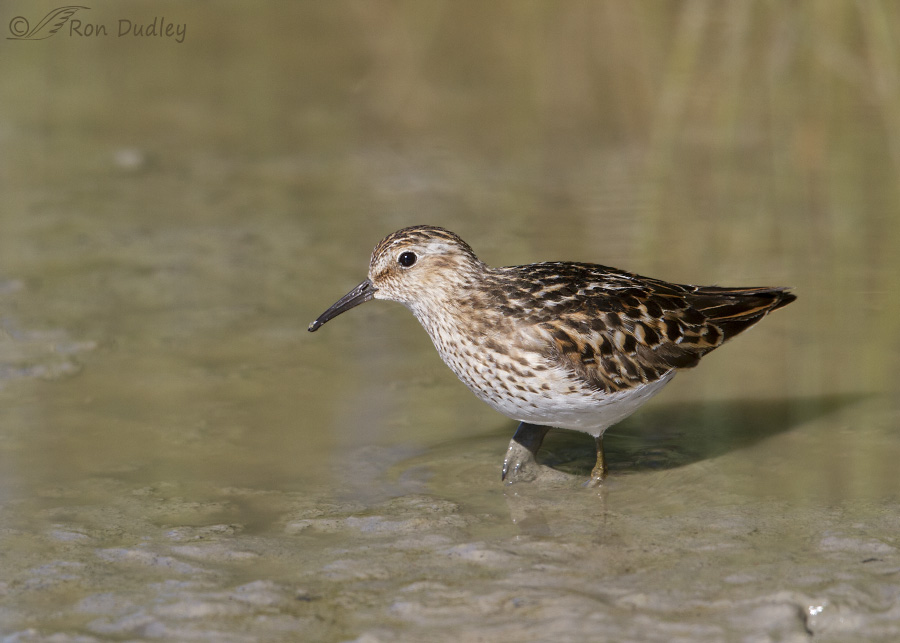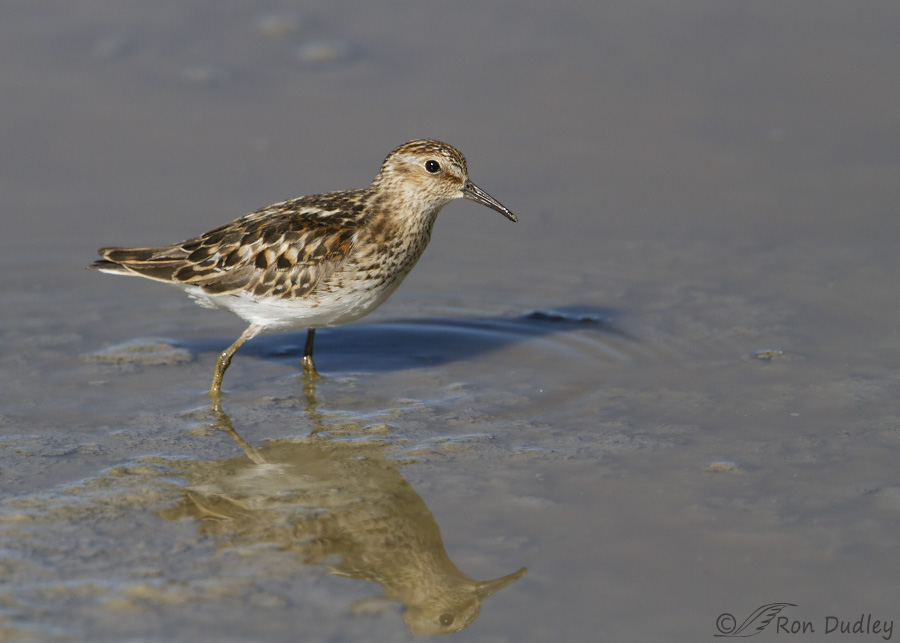During my Montana camping trip last week I was able to photograph two of the tiniest birds of their types in the world. The Northern Pygmy Owl with prey I posted a few days ago is one of the smallest owls in North America and the Least Sandpiper is the smallest shorebird in the world.

1/2000, f/6.3, ISO 500, Canon 7D, Canon EF 500mm f/4L IS II USM + 1.4 tc, not baited, set up or called in
I photographed this Least Sandpiper just over a week ago as it was feeding in a small pond at Red Rock Lakes National Wildlife Refuge. This was typical habitat for them as they often feed in exposed mud or grassy mudflats. These birds have already concluded their breeding season in the arctic tundra and far northern boreal forests and are in the midst of their migration to the Gulf Coast or Central and South America.

1/2500, f/6.3, ISO 500, Canon 7D, Canon EF 500mm f/4L IS II USM + 1.4 tc, not baited, set up or called in
Dang, these birds are tiny! Averaging only about .7 oz they’re barely larger than a typical sparrow and they’re the smallest of the peeps. That means the photographer must be quite close to them to get frame-filling shots but this species is known to be relatively tame and quite approachable. This one seemed unconcerned by my presence (I was in my pickup) as it was feeding in the mud.
Researchers studying this species and a few others have discovered an interesting and unique feeding mechanism. These little birds probe wet mud with their bills for food (small invertebrates) and then use the surface tension of water to transport prey very quickly from the tip of their bills to their mouths. The process is known as surface tension transport and it quickly and efficiently “wicks” a water droplet containing food to their mouths.
Bird photography is often a compromise and this image is no exception. This photo as presented is not level (a straight line from the eye of the bird to the eye in the reflection is not vertical). But when I rotate the image to level it I lose the top of the head and the eye in the reflection so I chose this composition as the lesser of two evils.
Ron


Definitely a good thing in a tiny package.
A phrase which I am defensive about since I am not often good and never tiny.
Susan is right. A shadow and a reflection is a rare treat. Bonus time.
Your second sentence made me smile, EC – something it’s getting more difficult to do these days so I’m grateful.
Nice photo. I think I saw this bird for the first time here in Utah late last summer. Have you noticed any yet this year?
No, I haven’t, April – not in Utah anyway.
Great shots Ron!
Charlotte
Thanks, Charlotte.
I love to sit on the beach sand during fall migration and watch these guys scurrying about as they probe endlessly for food. No problem with the image being level, I just tilt my head and it looks perfectly straight! (Maybe that’s why all my shots are crooked……)
…”tame and quite approachable”… ROFLMAO! The ones that spend the winter here have NOT received that memo!
“The ones that spend the winter here have NOT received that memo!”
That’s been my (admittedly limited) experience with them, Wally, and I found the same thing about them in the literature. Funny how the behavior of the same species can differ in different areas and situations.
I would never have known the second photo wasn’t level if you hadn’t said something about it. And I still can’t see it. I love the way that photo has both a shadow and a reflection of the subject. I’ve never seen a photo like that before (that I know of). I looked at the photo again and can now see what you were saying about level, but in this case I hardly see that as an “evil”. The things that draw my eye are the shadow and the reflection, not the lack of levelness.
Susan, it was probably hyperbole to refer to the lack of level in the image as “evil” but I don’t particularly like that it isn’t level because my eye notices it.
Love water birds with reflections!!!!!! I always go for reflections!!! Someday I will take great pictures like you. !!! ( yeah maybe) . the basin here has been invaded by pelicans . will they eat the young grebes?
“will they eat the young grebes?”
I highly doubt it, Marina. Mainly they eat fish along with a few aquatic amphibians and crayfish. But they’re opportunistic feeders and who knows what they might do if they came across a small disabled bird of any species.
Oh just WOW (plus the usual string of ridiculously redundant superlatives)!
I don’t know much about these guys, and oh what a joy it is to learn about them. Thank you! Overall, birds are just outrageously cool–every darn one of them! But the bird folk who do the insanely long migrations are beyond comprehension, especially since it’s often the littlest guys who cover the most miles with what we’d think are insurmountable obstacles. Just makes you wonder how they make that happen, and yet they do. Life is so persistent.
You wrote, “Bird photography is often a compromise…” Actually you could replace the word “bird” with life (in general).
I have no idea why you’re complaining about the vertical aspect of the eye and the eye in reflection. To my eye, it is vertical, and trust me, I’m not going to take out a protractor to measure it for exact precision. Trust me on that! 😉 Much better to have the head included in the shot. I hate decapitated birds/critters, and even humans for that matter 🙂
Ha, your last comment reminded me of my mother, Laura. She was (in)famous for cutting off the heads of people in her snapshots – especially my dad’s head because he was quite tall. He teased her mercilessly about that!
LOL! My mother did the same thing. Since I’m tall, I was a frequent subject for decapitation 😉
What great little birds!!! The last shot looks like a painting. Gorgeous!!
I’m delighted you like it, Carol. Thanks.
Great shots of the small yellow legged Sandpiper a key ID mark of the Least.
Sorry, but I don’t see anything wrong with either shot, and not being straight, not a problem with me.
As much as I love where we live, I do miss the ocean, especially this time of year during migration.
Dick, I guess I might be a little hypersensitive to images that need rotation. If I notice it isn’t level it distracts me.
3 birds for 1 in the last shot – bird/reflection/shadow! 🙂 They are tiny and, like hummingbirds, appear to make ridiculously long migrations! Don’t think I’ve ever seen one.
Judy, I wonder how many I’ve missed just because they’re so darned small I didn’t notice them…
Ron: I love this photo, because of all you said, and because of the three images, from top to bottom: bird, shadow, reflection. Neat!
Thanks, Richard. I agree – the reflection is important in that last shot and I thought it was very distracting when I rotated the image and cut off the top of the head of the bird. It looked decapitated.